University Economics Assignment: Global Warming and Policy
VerifiedAdded on 2020/02/18
|18
|4112
|94
Homework Assignment
AI Summary
This economics assignment delves into the critical issue of global warming, examining its causes, impacts, and potential solutions. Drawing upon Kenneth J. Arrow's article "Global Climate Change: A Challenge to Policy," the assignment analyzes the debate surrounding rising global temperatures, attributing it primarily to greenhouse gas emissions, particularly carbon dioxide. It explores the relationship between carbon emissions and temperature increases, highlighting the role of the Industrial Revolution and its impact on emission rates. The assignment discusses market failures associated with global warming, the cost-benefit analysis of implementing emission-reduction policies, and presents potential solutions such as transitioning to renewable energy sources, raising awareness, promoting technological innovations, and encouraging developed nations to lead in emission reductions. The assignment also includes analysis of the consumption discount rate and its economic interpretation in the context of global warming.
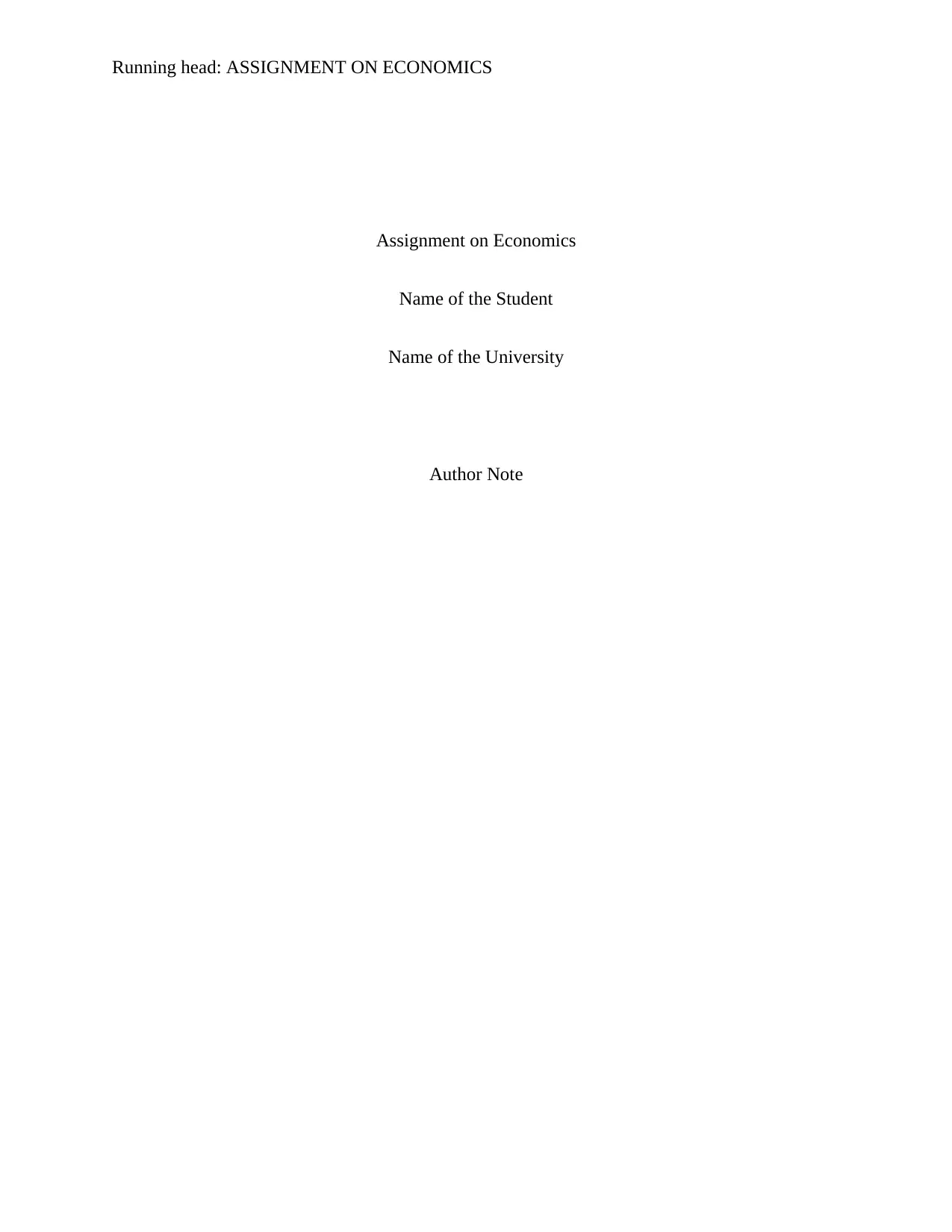
Running head: ASSIGNMENT ON ECONOMICS
Assignment on Economics
Name of the Student
Name of the University
Author Note
Assignment on Economics
Name of the Student
Name of the University
Author Note
Paraphrase This Document
Need a fresh take? Get an instant paraphrase of this document with our AI Paraphraser
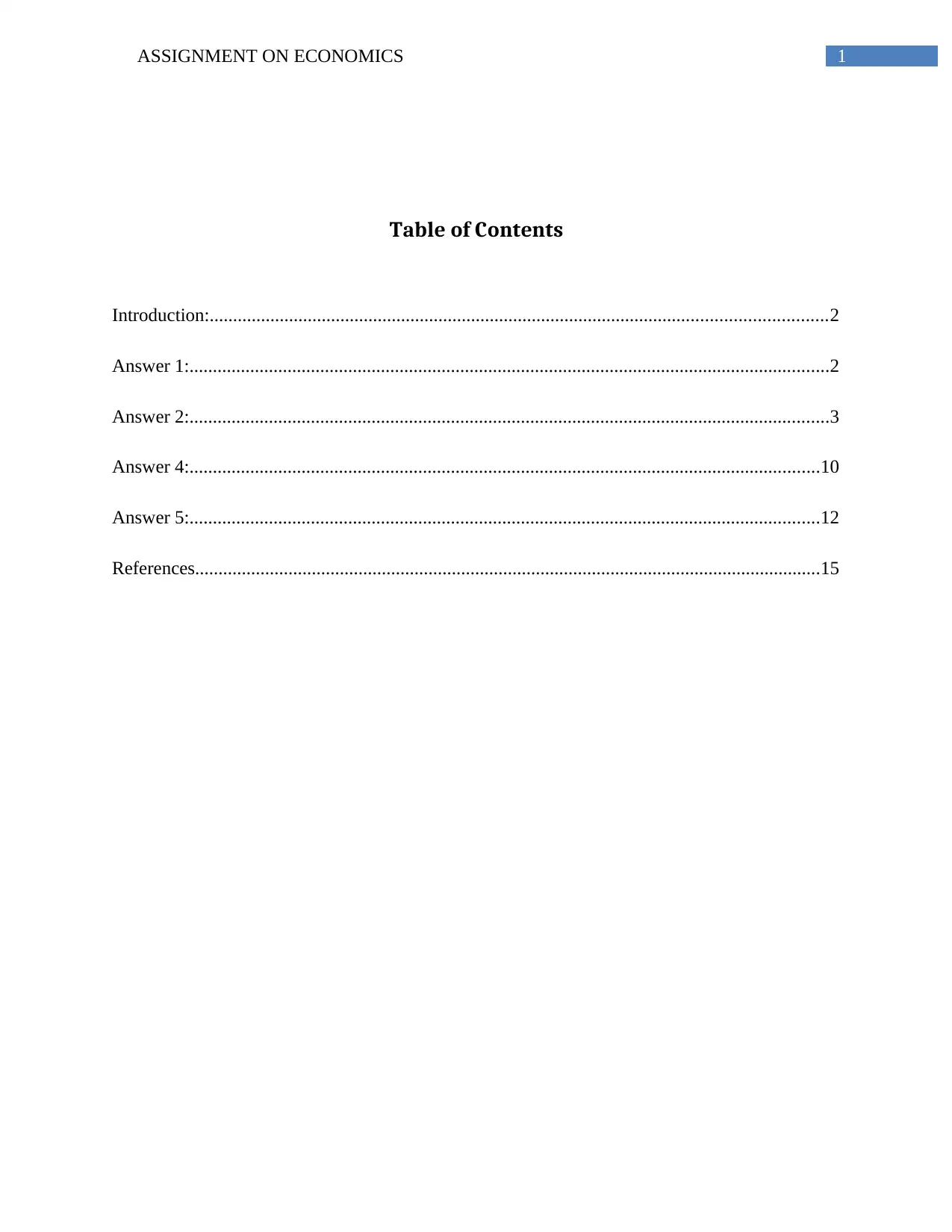
1ASSIGNMENT ON ECONOMICS
Table of Contents
Introduction:....................................................................................................................................2
Answer 1:.........................................................................................................................................2
Answer 2:.........................................................................................................................................3
Answer 4:.......................................................................................................................................10
Answer 5:.......................................................................................................................................12
References......................................................................................................................................15
Table of Contents
Introduction:....................................................................................................................................2
Answer 1:.........................................................................................................................................2
Answer 2:.........................................................................................................................................3
Answer 4:.......................................................................................................................................10
Answer 5:.......................................................................................................................................12
References......................................................................................................................................15
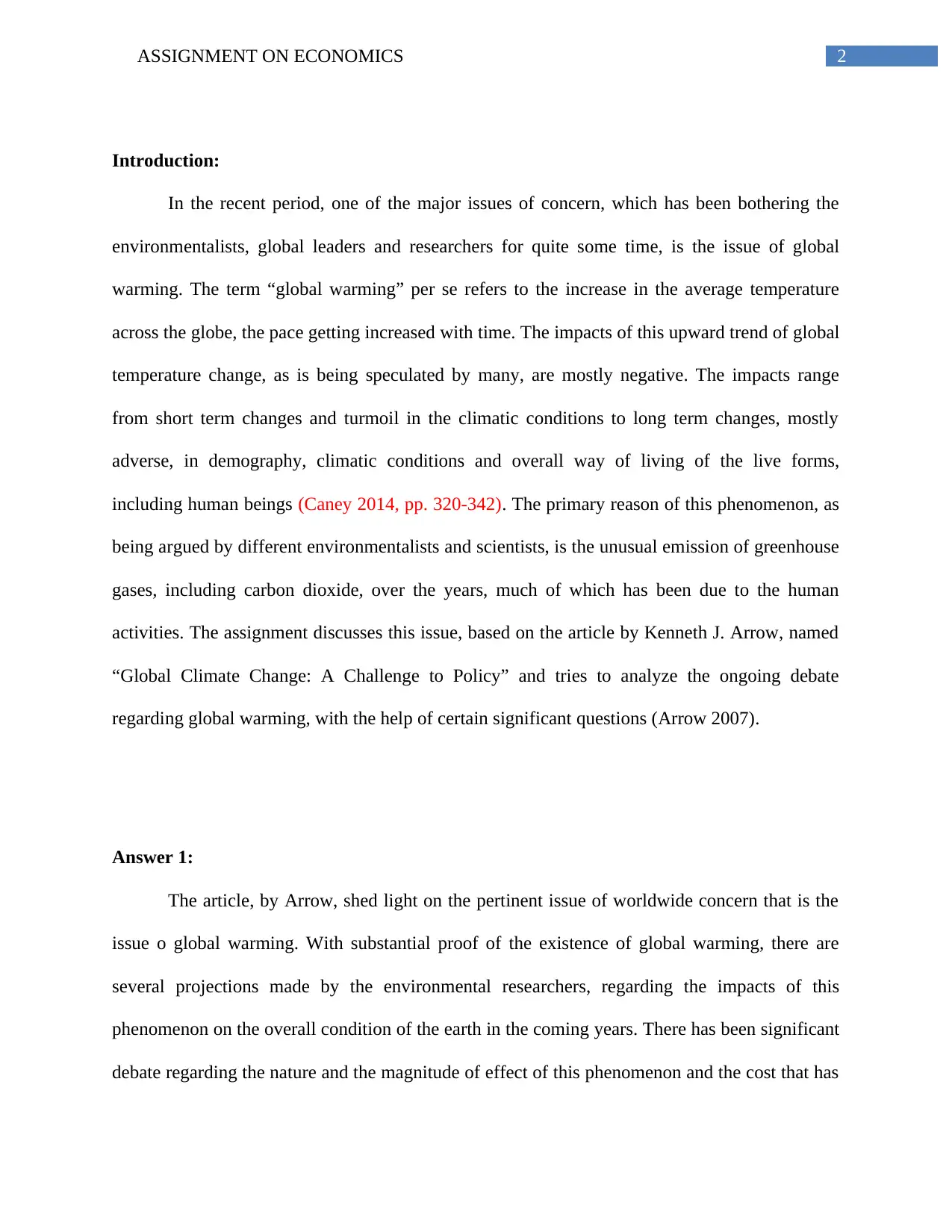
2ASSIGNMENT ON ECONOMICS
Introduction:
In the recent period, one of the major issues of concern, which has been bothering the
environmentalists, global leaders and researchers for quite some time, is the issue of global
warming. The term “global warming” per se refers to the increase in the average temperature
across the globe, the pace getting increased with time. The impacts of this upward trend of global
temperature change, as is being speculated by many, are mostly negative. The impacts range
from short term changes and turmoil in the climatic conditions to long term changes, mostly
adverse, in demography, climatic conditions and overall way of living of the live forms,
including human beings (Caney 2014, pp. 320-342). The primary reason of this phenomenon, as
being argued by different environmentalists and scientists, is the unusual emission of greenhouse
gases, including carbon dioxide, over the years, much of which has been due to the human
activities. The assignment discusses this issue, based on the article by Kenneth J. Arrow, named
“Global Climate Change: A Challenge to Policy” and tries to analyze the ongoing debate
regarding global warming, with the help of certain significant questions (Arrow 2007).
Answer 1:
The article, by Arrow, shed light on the pertinent issue of worldwide concern that is the
issue o global warming. With substantial proof of the existence of global warming, there are
several projections made by the environmental researchers, regarding the impacts of this
phenomenon on the overall condition of the earth in the coming years. There has been significant
debate regarding the nature and the magnitude of effect of this phenomenon and the cost that has
Introduction:
In the recent period, one of the major issues of concern, which has been bothering the
environmentalists, global leaders and researchers for quite some time, is the issue of global
warming. The term “global warming” per se refers to the increase in the average temperature
across the globe, the pace getting increased with time. The impacts of this upward trend of global
temperature change, as is being speculated by many, are mostly negative. The impacts range
from short term changes and turmoil in the climatic conditions to long term changes, mostly
adverse, in demography, climatic conditions and overall way of living of the live forms,
including human beings (Caney 2014, pp. 320-342). The primary reason of this phenomenon, as
being argued by different environmentalists and scientists, is the unusual emission of greenhouse
gases, including carbon dioxide, over the years, much of which has been due to the human
activities. The assignment discusses this issue, based on the article by Kenneth J. Arrow, named
“Global Climate Change: A Challenge to Policy” and tries to analyze the ongoing debate
regarding global warming, with the help of certain significant questions (Arrow 2007).
Answer 1:
The article, by Arrow, shed light on the pertinent issue of worldwide concern that is the
issue o global warming. With substantial proof of the existence of global warming, there are
several projections made by the environmental researchers, regarding the impacts of this
phenomenon on the overall condition of the earth in the coming years. There has been significant
debate regarding the nature and the magnitude of effect of this phenomenon and the cost that has
⊘ This is a preview!⊘
Do you want full access?
Subscribe today to unlock all pages.

Trusted by 1+ million students worldwide
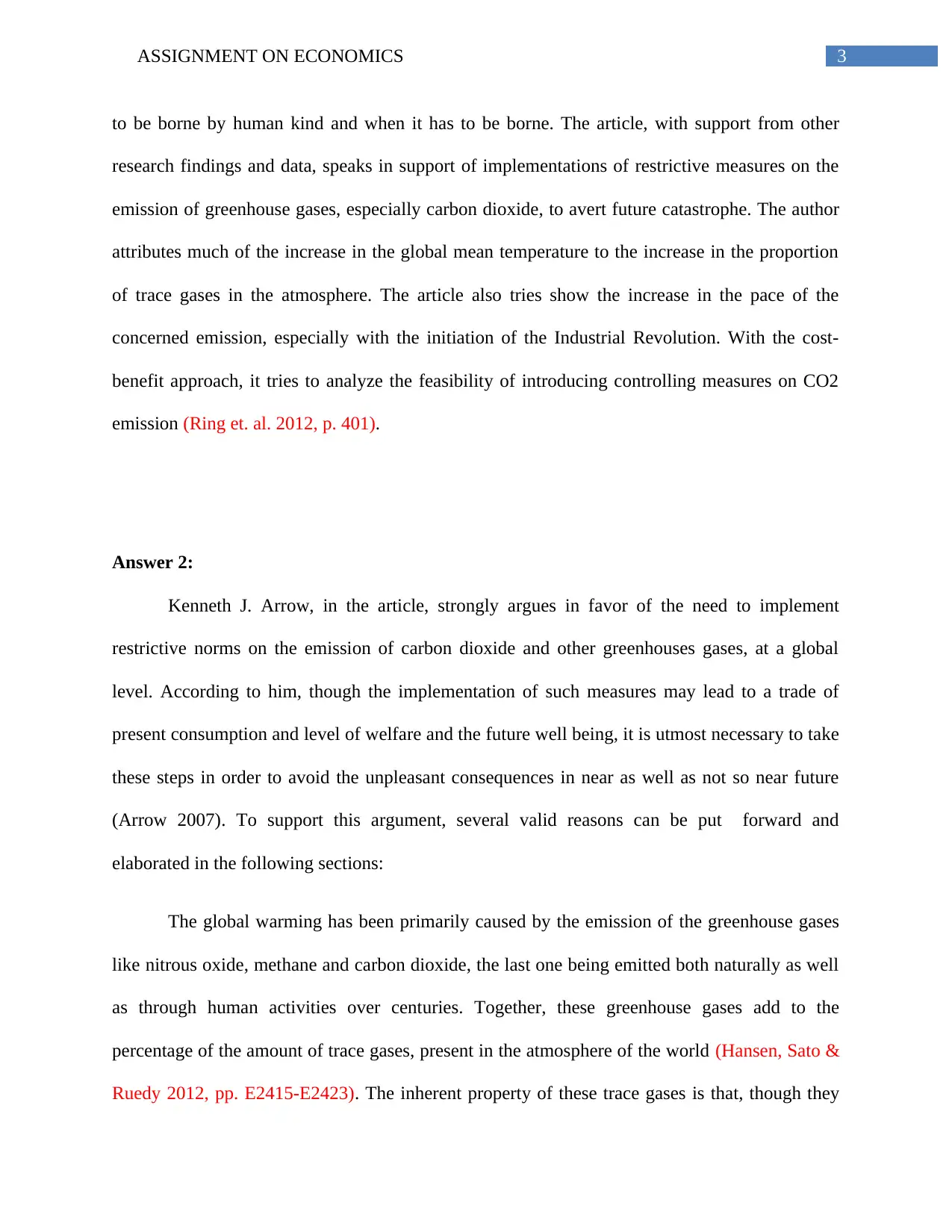
3ASSIGNMENT ON ECONOMICS
to be borne by human kind and when it has to be borne. The article, with support from other
research findings and data, speaks in support of implementations of restrictive measures on the
emission of greenhouse gases, especially carbon dioxide, to avert future catastrophe. The author
attributes much of the increase in the global mean temperature to the increase in the proportion
of trace gases in the atmosphere. The article also tries show the increase in the pace of the
concerned emission, especially with the initiation of the Industrial Revolution. With the cost-
benefit approach, it tries to analyze the feasibility of introducing controlling measures on CO2
emission (Ring et. al. 2012, p. 401).
Answer 2:
Kenneth J. Arrow, in the article, strongly argues in favor of the need to implement
restrictive norms on the emission of carbon dioxide and other greenhouses gases, at a global
level. According to him, though the implementation of such measures may lead to a trade of
present consumption and level of welfare and the future well being, it is utmost necessary to take
these steps in order to avoid the unpleasant consequences in near as well as not so near future
(Arrow 2007). To support this argument, several valid reasons can be put forward and
elaborated in the following sections:
The global warming has been primarily caused by the emission of the greenhouse gases
like nitrous oxide, methane and carbon dioxide, the last one being emitted both naturally as well
as through human activities over centuries. Together, these greenhouse gases add to the
percentage of the amount of trace gases, present in the atmosphere of the world (Hansen, Sato &
Ruedy 2012, pp. E2415-E2423). The inherent property of these trace gases is that, though they
to be borne by human kind and when it has to be borne. The article, with support from other
research findings and data, speaks in support of implementations of restrictive measures on the
emission of greenhouse gases, especially carbon dioxide, to avert future catastrophe. The author
attributes much of the increase in the global mean temperature to the increase in the proportion
of trace gases in the atmosphere. The article also tries show the increase in the pace of the
concerned emission, especially with the initiation of the Industrial Revolution. With the cost-
benefit approach, it tries to analyze the feasibility of introducing controlling measures on CO2
emission (Ring et. al. 2012, p. 401).
Answer 2:
Kenneth J. Arrow, in the article, strongly argues in favor of the need to implement
restrictive norms on the emission of carbon dioxide and other greenhouses gases, at a global
level. According to him, though the implementation of such measures may lead to a trade of
present consumption and level of welfare and the future well being, it is utmost necessary to take
these steps in order to avoid the unpleasant consequences in near as well as not so near future
(Arrow 2007). To support this argument, several valid reasons can be put forward and
elaborated in the following sections:
The global warming has been primarily caused by the emission of the greenhouse gases
like nitrous oxide, methane and carbon dioxide, the last one being emitted both naturally as well
as through human activities over centuries. Together, these greenhouse gases add to the
percentage of the amount of trace gases, present in the atmosphere of the world (Hansen, Sato &
Ruedy 2012, pp. E2415-E2423). The inherent property of these trace gases is that, though they
Paraphrase This Document
Need a fresh take? Get an instant paraphrase of this document with our AI Paraphraser
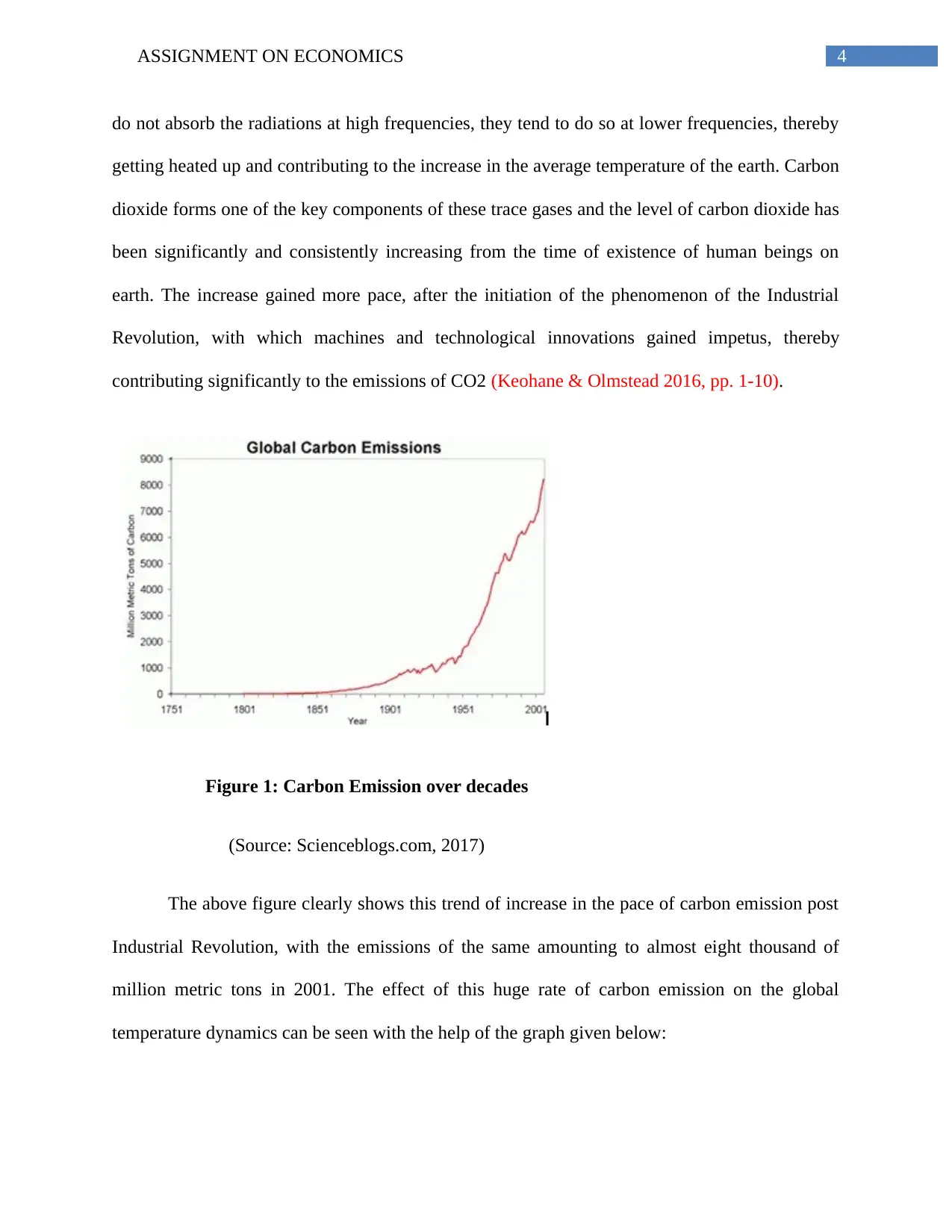
4ASSIGNMENT ON ECONOMICS
do not absorb the radiations at high frequencies, they tend to do so at lower frequencies, thereby
getting heated up and contributing to the increase in the average temperature of the earth. Carbon
dioxide forms one of the key components of these trace gases and the level of carbon dioxide has
been significantly and consistently increasing from the time of existence of human beings on
earth. The increase gained more pace, after the initiation of the phenomenon of the Industrial
Revolution, with which machines and technological innovations gained impetus, thereby
contributing significantly to the emissions of CO2 (Keohane & Olmstead 2016, pp. 1-10).
Figure 1: Carbon Emission over decades
(Source: Scienceblogs.com, 2017)
The above figure clearly shows this trend of increase in the pace of carbon emission post
Industrial Revolution, with the emissions of the same amounting to almost eight thousand of
million metric tons in 2001. The effect of this huge rate of carbon emission on the global
temperature dynamics can be seen with the help of the graph given below:
do not absorb the radiations at high frequencies, they tend to do so at lower frequencies, thereby
getting heated up and contributing to the increase in the average temperature of the earth. Carbon
dioxide forms one of the key components of these trace gases and the level of carbon dioxide has
been significantly and consistently increasing from the time of existence of human beings on
earth. The increase gained more pace, after the initiation of the phenomenon of the Industrial
Revolution, with which machines and technological innovations gained impetus, thereby
contributing significantly to the emissions of CO2 (Keohane & Olmstead 2016, pp. 1-10).
Figure 1: Carbon Emission over decades
(Source: Scienceblogs.com, 2017)
The above figure clearly shows this trend of increase in the pace of carbon emission post
Industrial Revolution, with the emissions of the same amounting to almost eight thousand of
million metric tons in 2001. The effect of this huge rate of carbon emission on the global
temperature dynamics can be seen with the help of the graph given below:
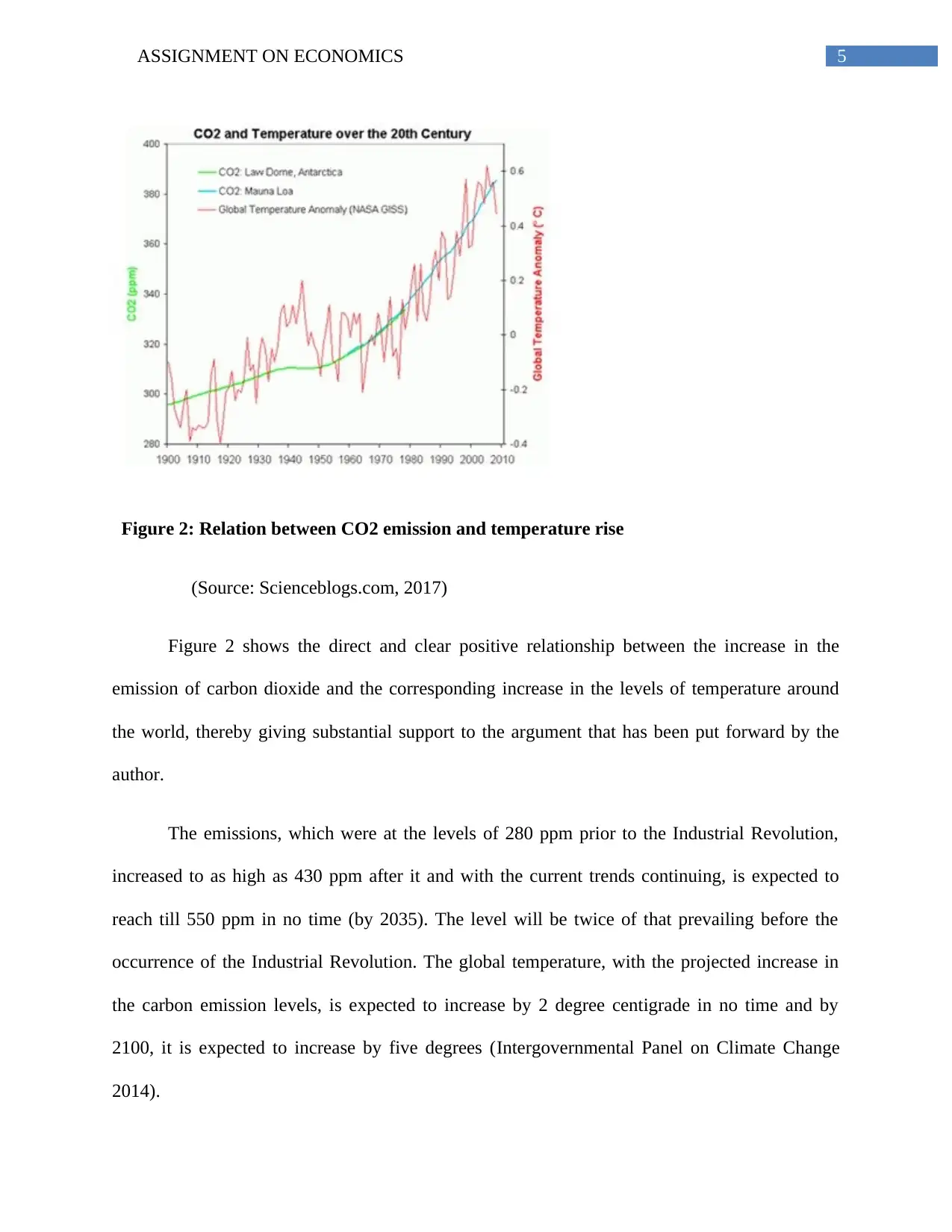
5ASSIGNMENT ON ECONOMICS
Figure 2: Relation between CO2 emission and temperature rise
(Source: Scienceblogs.com, 2017)
Figure 2 shows the direct and clear positive relationship between the increase in the
emission of carbon dioxide and the corresponding increase in the levels of temperature around
the world, thereby giving substantial support to the argument that has been put forward by the
author.
The emissions, which were at the levels of 280 ppm prior to the Industrial Revolution,
increased to as high as 430 ppm after it and with the current trends continuing, is expected to
reach till 550 ppm in no time (by 2035). The level will be twice of that prevailing before the
occurrence of the Industrial Revolution. The global temperature, with the projected increase in
the carbon emission levels, is expected to increase by 2 degree centigrade in no time and by
2100, it is expected to increase by five degrees (Intergovernmental Panel on Climate Change
2014).
Figure 2: Relation between CO2 emission and temperature rise
(Source: Scienceblogs.com, 2017)
Figure 2 shows the direct and clear positive relationship between the increase in the
emission of carbon dioxide and the corresponding increase in the levels of temperature around
the world, thereby giving substantial support to the argument that has been put forward by the
author.
The emissions, which were at the levels of 280 ppm prior to the Industrial Revolution,
increased to as high as 430 ppm after it and with the current trends continuing, is expected to
reach till 550 ppm in no time (by 2035). The level will be twice of that prevailing before the
occurrence of the Industrial Revolution. The global temperature, with the projected increase in
the carbon emission levels, is expected to increase by 2 degree centigrade in no time and by
2100, it is expected to increase by five degrees (Intergovernmental Panel on Climate Change
2014).
⊘ This is a preview!⊘
Do you want full access?
Subscribe today to unlock all pages.

Trusted by 1+ million students worldwide
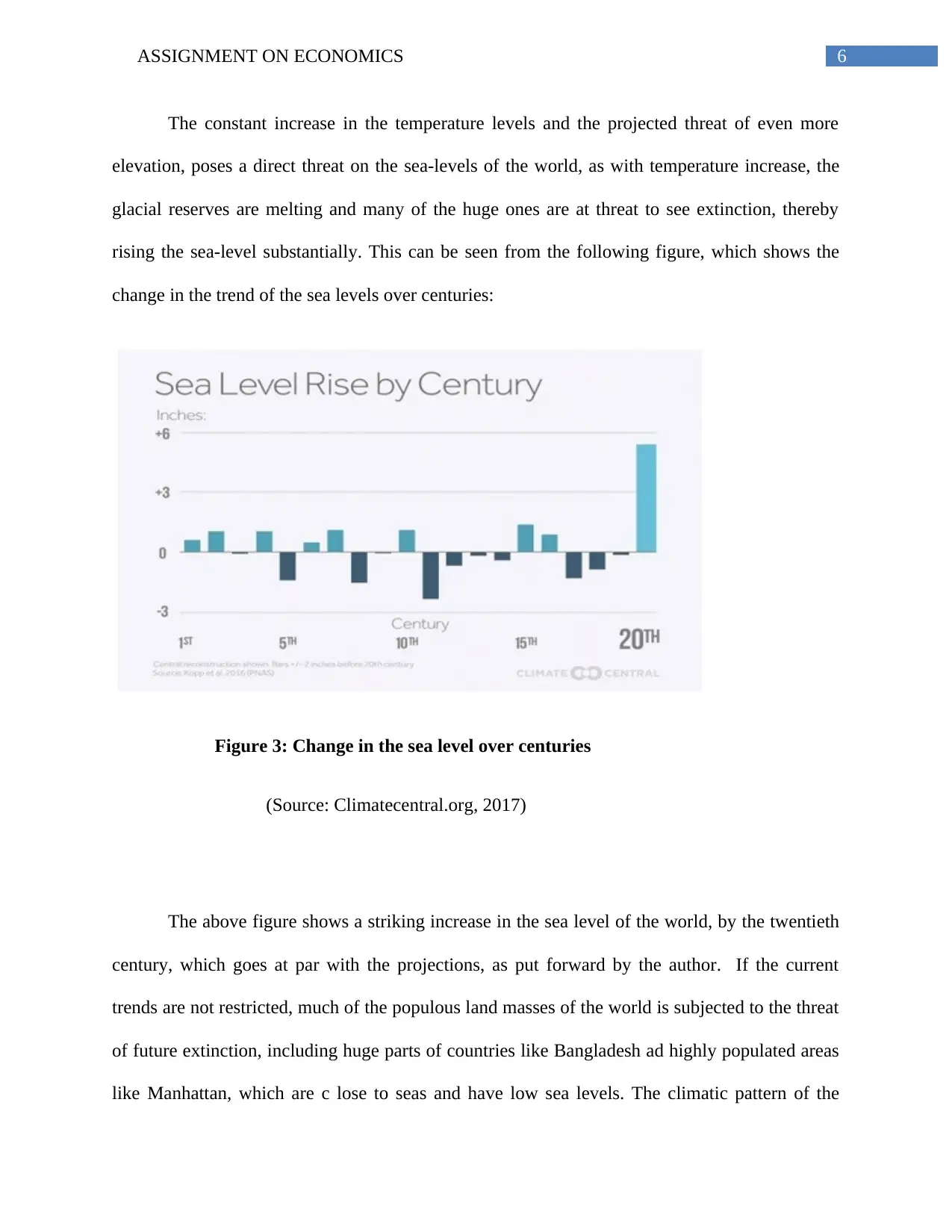
6ASSIGNMENT ON ECONOMICS
The constant increase in the temperature levels and the projected threat of even more
elevation, poses a direct threat on the sea-levels of the world, as with temperature increase, the
glacial reserves are melting and many of the huge ones are at threat to see extinction, thereby
rising the sea-level substantially. This can be seen from the following figure, which shows the
change in the trend of the sea levels over centuries:
Figure 3: Change in the sea level over centuries
(Source: Climatecentral.org, 2017)
The above figure shows a striking increase in the sea level of the world, by the twentieth
century, which goes at par with the projections, as put forward by the author. If the current
trends are not restricted, much of the populous land masses of the world is subjected to the threat
of future extinction, including huge parts of countries like Bangladesh ad highly populated areas
like Manhattan, which are c lose to seas and have low sea levels. The climatic pattern of the
The constant increase in the temperature levels and the projected threat of even more
elevation, poses a direct threat on the sea-levels of the world, as with temperature increase, the
glacial reserves are melting and many of the huge ones are at threat to see extinction, thereby
rising the sea-level substantially. This can be seen from the following figure, which shows the
change in the trend of the sea levels over centuries:
Figure 3: Change in the sea level over centuries
(Source: Climatecentral.org, 2017)
The above figure shows a striking increase in the sea level of the world, by the twentieth
century, which goes at par with the projections, as put forward by the author. If the current
trends are not restricted, much of the populous land masses of the world is subjected to the threat
of future extinction, including huge parts of countries like Bangladesh ad highly populated areas
like Manhattan, which are c lose to seas and have low sea levels. The climatic pattern of the
Paraphrase This Document
Need a fresh take? Get an instant paraphrase of this document with our AI Paraphraser
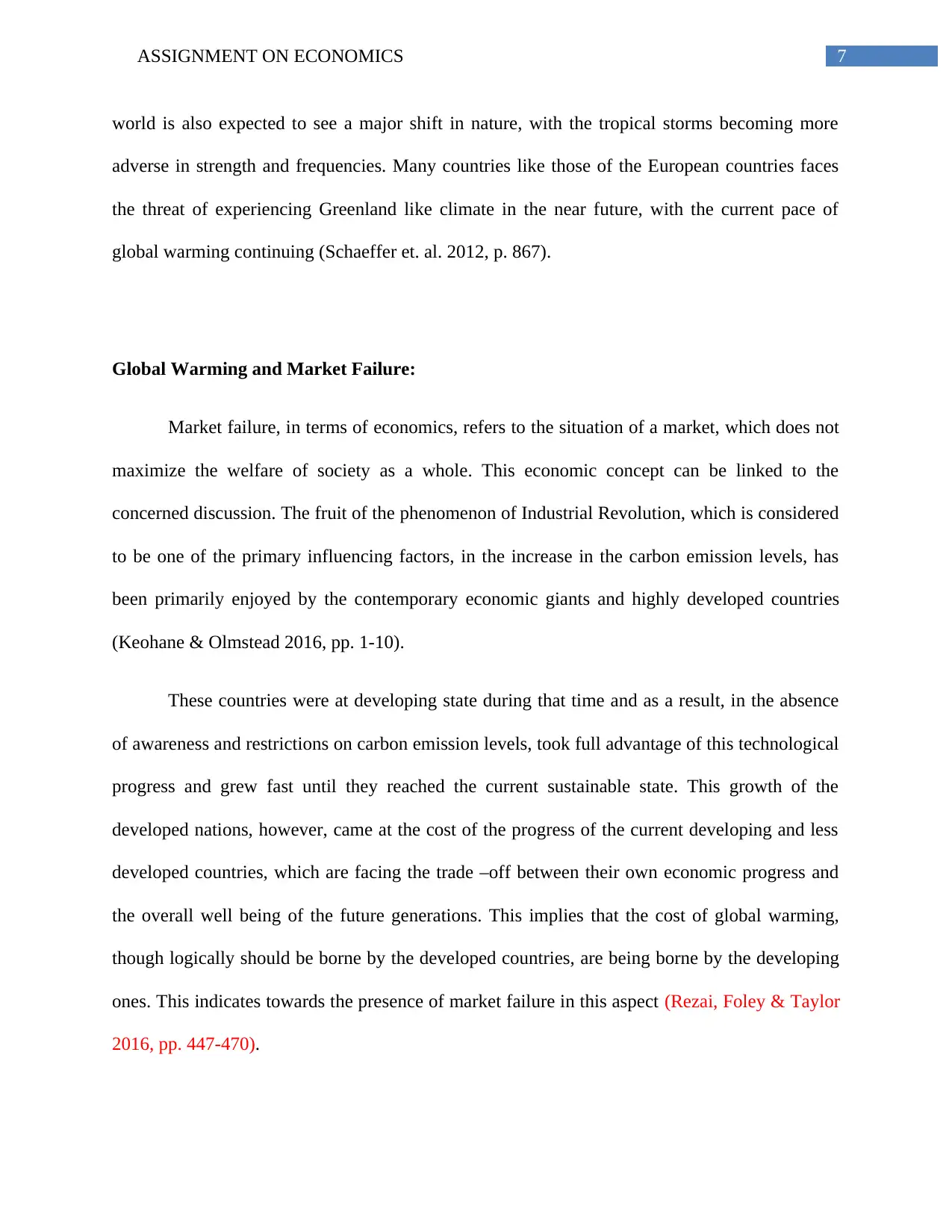
7ASSIGNMENT ON ECONOMICS
world is also expected to see a major shift in nature, with the tropical storms becoming more
adverse in strength and frequencies. Many countries like those of the European countries faces
the threat of experiencing Greenland like climate in the near future, with the current pace of
global warming continuing (Schaeffer et. al. 2012, p. 867).
Global Warming and Market Failure:
Market failure, in terms of economics, refers to the situation of a market, which does not
maximize the welfare of society as a whole. This economic concept can be linked to the
concerned discussion. The fruit of the phenomenon of Industrial Revolution, which is considered
to be one of the primary influencing factors, in the increase in the carbon emission levels, has
been primarily enjoyed by the contemporary economic giants and highly developed countries
(Keohane & Olmstead 2016, pp. 1-10).
These countries were at developing state during that time and as a result, in the absence
of awareness and restrictions on carbon emission levels, took full advantage of this technological
progress and grew fast until they reached the current sustainable state. This growth of the
developed nations, however, came at the cost of the progress of the current developing and less
developed countries, which are facing the trade –off between their own economic progress and
the overall well being of the future generations. This implies that the cost of global warming,
though logically should be borne by the developed countries, are being borne by the developing
ones. This indicates towards the presence of market failure in this aspect (Rezai, Foley & Taylor
2016, pp. 447-470).
world is also expected to see a major shift in nature, with the tropical storms becoming more
adverse in strength and frequencies. Many countries like those of the European countries faces
the threat of experiencing Greenland like climate in the near future, with the current pace of
global warming continuing (Schaeffer et. al. 2012, p. 867).
Global Warming and Market Failure:
Market failure, in terms of economics, refers to the situation of a market, which does not
maximize the welfare of society as a whole. This economic concept can be linked to the
concerned discussion. The fruit of the phenomenon of Industrial Revolution, which is considered
to be one of the primary influencing factors, in the increase in the carbon emission levels, has
been primarily enjoyed by the contemporary economic giants and highly developed countries
(Keohane & Olmstead 2016, pp. 1-10).
These countries were at developing state during that time and as a result, in the absence
of awareness and restrictions on carbon emission levels, took full advantage of this technological
progress and grew fast until they reached the current sustainable state. This growth of the
developed nations, however, came at the cost of the progress of the current developing and less
developed countries, which are facing the trade –off between their own economic progress and
the overall well being of the future generations. This implies that the cost of global warming,
though logically should be borne by the developed countries, are being borne by the developing
ones. This indicates towards the presence of market failure in this aspect (Rezai, Foley & Taylor
2016, pp. 447-470).
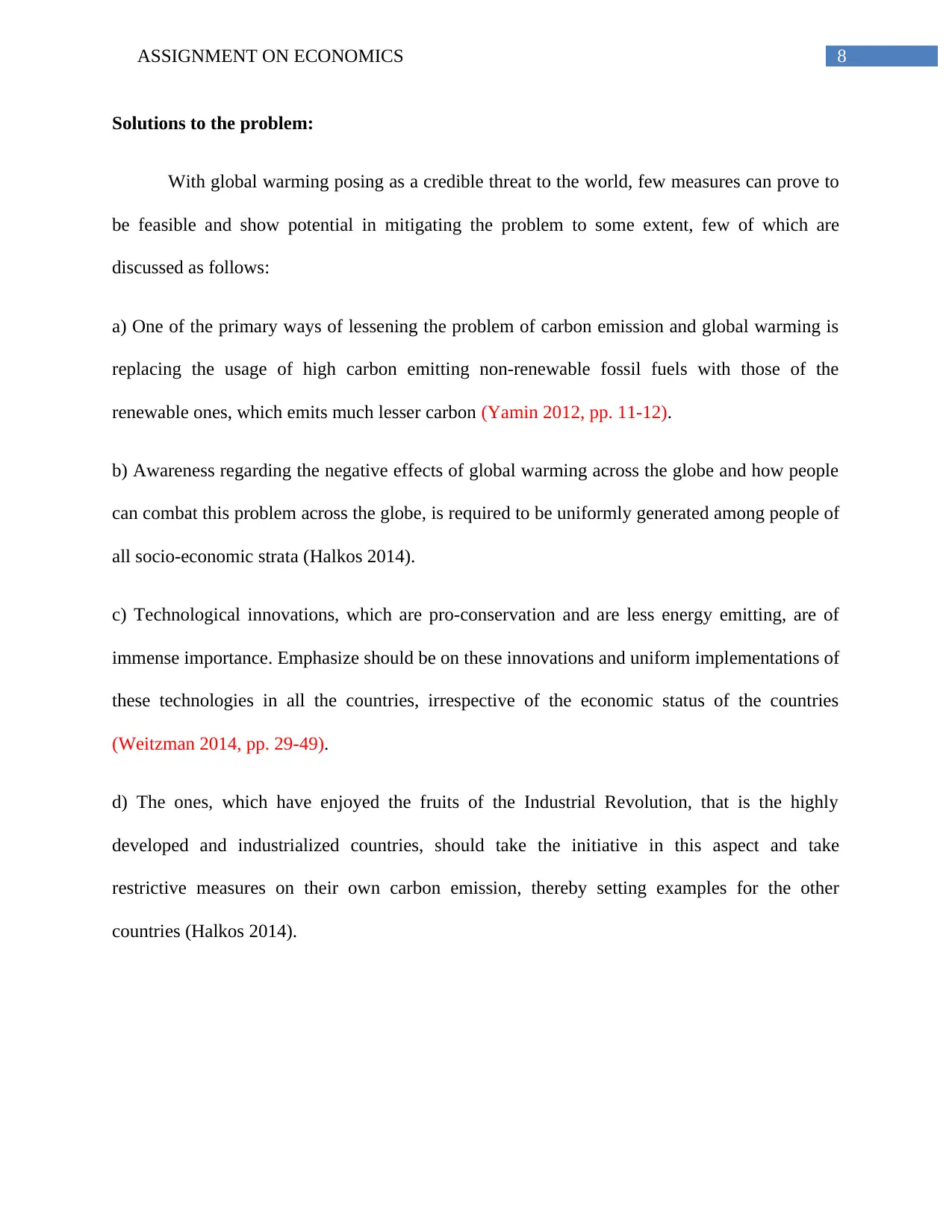
8ASSIGNMENT ON ECONOMICS
Solutions to the problem:
With global warming posing as a credible threat to the world, few measures can prove to
be feasible and show potential in mitigating the problem to some extent, few of which are
discussed as follows:
a) One of the primary ways of lessening the problem of carbon emission and global warming is
replacing the usage of high carbon emitting non-renewable fossil fuels with those of the
renewable ones, which emits much lesser carbon (Yamin 2012, pp. 11-12).
b) Awareness regarding the negative effects of global warming across the globe and how people
can combat this problem across the globe, is required to be uniformly generated among people of
all socio-economic strata (Halkos 2014).
c) Technological innovations, which are pro-conservation and are less energy emitting, are of
immense importance. Emphasize should be on these innovations and uniform implementations of
these technologies in all the countries, irrespective of the economic status of the countries
(Weitzman 2014, pp. 29-49).
d) The ones, which have enjoyed the fruits of the Industrial Revolution, that is the highly
developed and industrialized countries, should take the initiative in this aspect and take
restrictive measures on their own carbon emission, thereby setting examples for the other
countries (Halkos 2014).
Solutions to the problem:
With global warming posing as a credible threat to the world, few measures can prove to
be feasible and show potential in mitigating the problem to some extent, few of which are
discussed as follows:
a) One of the primary ways of lessening the problem of carbon emission and global warming is
replacing the usage of high carbon emitting non-renewable fossil fuels with those of the
renewable ones, which emits much lesser carbon (Yamin 2012, pp. 11-12).
b) Awareness regarding the negative effects of global warming across the globe and how people
can combat this problem across the globe, is required to be uniformly generated among people of
all socio-economic strata (Halkos 2014).
c) Technological innovations, which are pro-conservation and are less energy emitting, are of
immense importance. Emphasize should be on these innovations and uniform implementations of
these technologies in all the countries, irrespective of the economic status of the countries
(Weitzman 2014, pp. 29-49).
d) The ones, which have enjoyed the fruits of the Industrial Revolution, that is the highly
developed and industrialized countries, should take the initiative in this aspect and take
restrictive measures on their own carbon emission, thereby setting examples for the other
countries (Halkos 2014).
⊘ This is a preview!⊘
Do you want full access?
Subscribe today to unlock all pages.

Trusted by 1+ million students worldwide
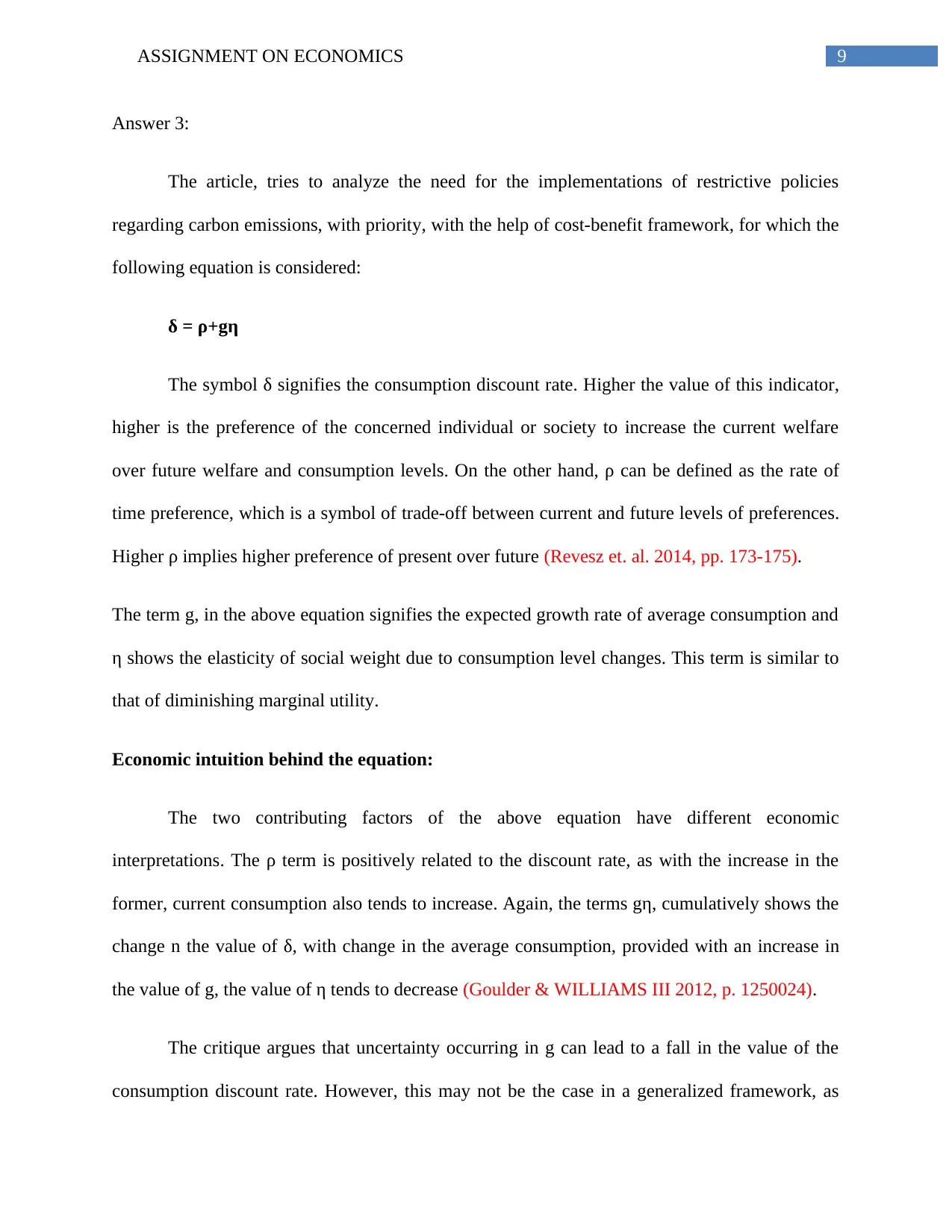
9ASSIGNMENT ON ECONOMICS
Answer 3:
The article, tries to analyze the need for the implementations of restrictive policies
regarding carbon emissions, with priority, with the help of cost-benefit framework, for which the
following equation is considered:
δ = ρ+gη
The symbol δ signifies the consumption discount rate. Higher the value of this indicator,
higher is the preference of the concerned individual or society to increase the current welfare
over future welfare and consumption levels. On the other hand, ρ can be defined as the rate of
time preference, which is a symbol of trade-off between current and future levels of preferences.
Higher ρ implies higher preference of present over future (Revesz et. al. 2014, pp. 173-175).
The term g, in the above equation signifies the expected growth rate of average consumption and
η shows the elasticity of social weight due to consumption level changes. This term is similar to
that of diminishing marginal utility.
Economic intuition behind the equation:
The two contributing factors of the above equation have different economic
interpretations. The ρ term is positively related to the discount rate, as with the increase in the
former, current consumption also tends to increase. Again, the terms gη, cumulatively shows the
change n the value of δ, with change in the average consumption, provided with an increase in
the value of g, the value of η tends to decrease (Goulder & WILLIAMS III 2012, p. 1250024).
The critique argues that uncertainty occurring in g can lead to a fall in the value of the
consumption discount rate. However, this may not be the case in a generalized framework, as
Answer 3:
The article, tries to analyze the need for the implementations of restrictive policies
regarding carbon emissions, with priority, with the help of cost-benefit framework, for which the
following equation is considered:
δ = ρ+gη
The symbol δ signifies the consumption discount rate. Higher the value of this indicator,
higher is the preference of the concerned individual or society to increase the current welfare
over future welfare and consumption levels. On the other hand, ρ can be defined as the rate of
time preference, which is a symbol of trade-off between current and future levels of preferences.
Higher ρ implies higher preference of present over future (Revesz et. al. 2014, pp. 173-175).
The term g, in the above equation signifies the expected growth rate of average consumption and
η shows the elasticity of social weight due to consumption level changes. This term is similar to
that of diminishing marginal utility.
Economic intuition behind the equation:
The two contributing factors of the above equation have different economic
interpretations. The ρ term is positively related to the discount rate, as with the increase in the
former, current consumption also tends to increase. Again, the terms gη, cumulatively shows the
change n the value of δ, with change in the average consumption, provided with an increase in
the value of g, the value of η tends to decrease (Goulder & WILLIAMS III 2012, p. 1250024).
The critique argues that uncertainty occurring in g can lead to a fall in the value of the
consumption discount rate. However, this may not be the case in a generalized framework, as
Paraphrase This Document
Need a fresh take? Get an instant paraphrase of this document with our AI Paraphraser
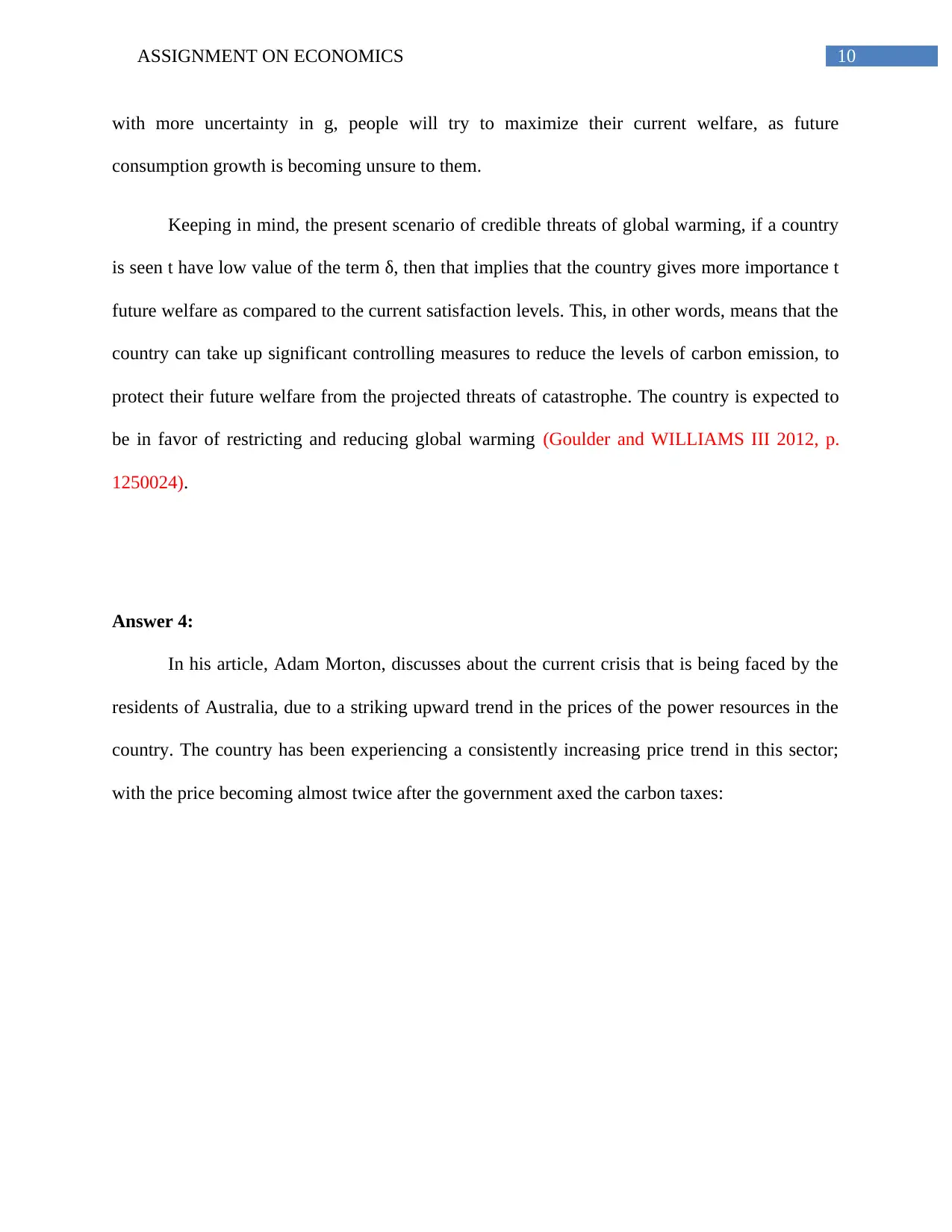
10ASSIGNMENT ON ECONOMICS
with more uncertainty in g, people will try to maximize their current welfare, as future
consumption growth is becoming unsure to them.
Keeping in mind, the present scenario of credible threats of global warming, if a country
is seen t have low value of the term δ, then that implies that the country gives more importance t
future welfare as compared to the current satisfaction levels. This, in other words, means that the
country can take up significant controlling measures to reduce the levels of carbon emission, to
protect their future welfare from the projected threats of catastrophe. The country is expected to
be in favor of restricting and reducing global warming (Goulder and WILLIAMS III 2012, p.
1250024).
Answer 4:
In his article, Adam Morton, discusses about the current crisis that is being faced by the
residents of Australia, due to a striking upward trend in the prices of the power resources in the
country. The country has been experiencing a consistently increasing price trend in this sector;
with the price becoming almost twice after the government axed the carbon taxes:
with more uncertainty in g, people will try to maximize their current welfare, as future
consumption growth is becoming unsure to them.
Keeping in mind, the present scenario of credible threats of global warming, if a country
is seen t have low value of the term δ, then that implies that the country gives more importance t
future welfare as compared to the current satisfaction levels. This, in other words, means that the
country can take up significant controlling measures to reduce the levels of carbon emission, to
protect their future welfare from the projected threats of catastrophe. The country is expected to
be in favor of restricting and reducing global warming (Goulder and WILLIAMS III 2012, p.
1250024).
Answer 4:
In his article, Adam Morton, discusses about the current crisis that is being faced by the
residents of Australia, due to a striking upward trend in the prices of the power resources in the
country. The country has been experiencing a consistently increasing price trend in this sector;
with the price becoming almost twice after the government axed the carbon taxes:
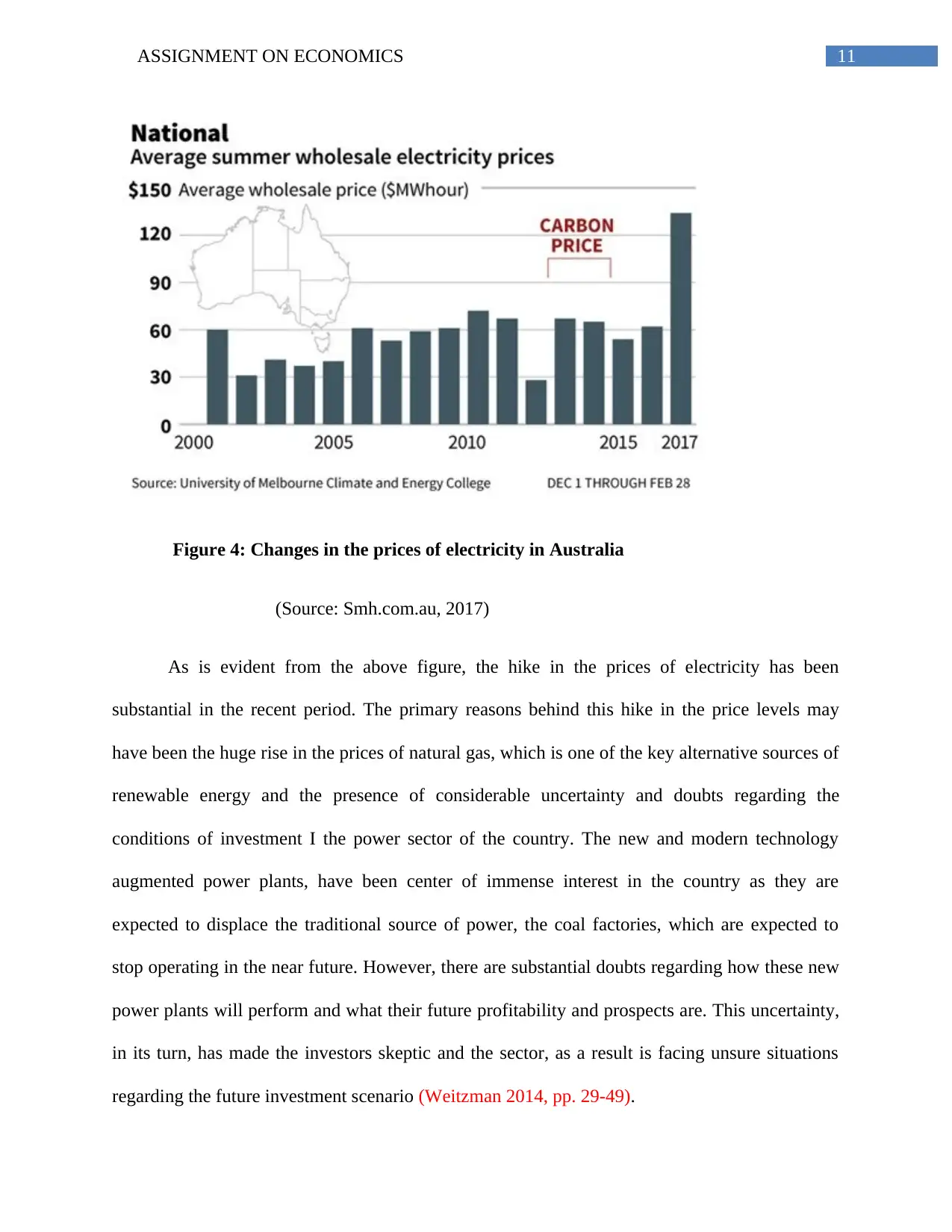
11ASSIGNMENT ON ECONOMICS
Figure 4: Changes in the prices of electricity in Australia
(Source: Smh.com.au, 2017)
As is evident from the above figure, the hike in the prices of electricity has been
substantial in the recent period. The primary reasons behind this hike in the price levels may
have been the huge rise in the prices of natural gas, which is one of the key alternative sources of
renewable energy and the presence of considerable uncertainty and doubts regarding the
conditions of investment I the power sector of the country. The new and modern technology
augmented power plants, have been center of immense interest in the country as they are
expected to displace the traditional source of power, the coal factories, which are expected to
stop operating in the near future. However, there are substantial doubts regarding how these new
power plants will perform and what their future profitability and prospects are. This uncertainty,
in its turn, has made the investors skeptic and the sector, as a result is facing unsure situations
regarding the future investment scenario (Weitzman 2014, pp. 29-49).
Figure 4: Changes in the prices of electricity in Australia
(Source: Smh.com.au, 2017)
As is evident from the above figure, the hike in the prices of electricity has been
substantial in the recent period. The primary reasons behind this hike in the price levels may
have been the huge rise in the prices of natural gas, which is one of the key alternative sources of
renewable energy and the presence of considerable uncertainty and doubts regarding the
conditions of investment I the power sector of the country. The new and modern technology
augmented power plants, have been center of immense interest in the country as they are
expected to displace the traditional source of power, the coal factories, which are expected to
stop operating in the near future. However, there are substantial doubts regarding how these new
power plants will perform and what their future profitability and prospects are. This uncertainty,
in its turn, has made the investors skeptic and the sector, as a result is facing unsure situations
regarding the future investment scenario (Weitzman 2014, pp. 29-49).
⊘ This is a preview!⊘
Do you want full access?
Subscribe today to unlock all pages.

Trusted by 1+ million students worldwide
1 out of 18
Related Documents
Your All-in-One AI-Powered Toolkit for Academic Success.
+13062052269
info@desklib.com
Available 24*7 on WhatsApp / Email
![[object Object]](/_next/static/media/star-bottom.7253800d.svg)
Unlock your academic potential
Copyright © 2020–2025 A2Z Services. All Rights Reserved. Developed and managed by ZUCOL.





